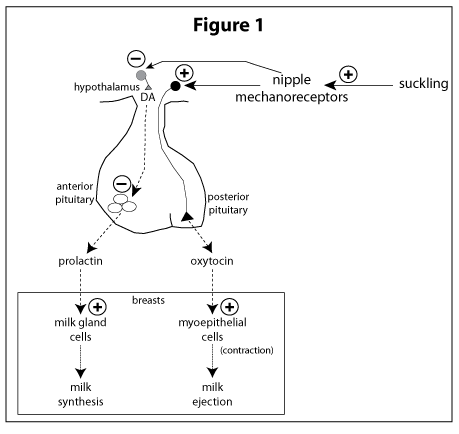Prolactin (Lactogenic Hormone)

The hypothalamus releases the following Releasing Hormones that stimulate the release of different hormones from the adenohypophysis:
- Corticotropin Releasing Hormone (C.R.H. causes the release of ACTH)
- Thyrotropin Releasing Hormone (T.R.H. causes the release of Thyroid Stimulating Hormone aka Thyrotropin)
- Gonadotropin Releasing Hormone (GnRH releases LH and FSH.)
- Growth Hormone R.H. & Growth Hormone I.H.
- Prolactin R.H. & Prolactin I.H.
In this post, we’re concerned with #5.
Prolactin, a non-tropic hormone: The word lacto- means milk. Lactose is the sugar in milk. If a women is lactating, it means she’s producing milk. Prolactin is the hormone that stimulates the mammary glands to produce milk.
During pregnancy, prolactin stimulates growth of the breast, but high estrogen and progesterone secretion prevent milk production. After delivery, estrogen and progesterone levels drop, and prolactin stimulates the secretion of milk by alveolar cells in the breast. Milk-let down or milk ejection is the name for milk squirting out a nipple.
If a woman has prolactin causing milk production but no oxytocin, then what happens? Remember oxytocin is the non-tropic hormone that causes milk to be squirted out (and uterine contractions). If they are producing milk and it’s not coming out, then they will have very, very full breasts.
There’s no negative feedback loop from the mammary gland for prolactin. Milk comes out the nipple, so it can’t loop back to the pituitary. Prolactin Releasing Hormone (PRH) and nursing of a baby stimulate the release of Prolactin. Remember the hypothalamic-pituitary portal veins are what carry the Prolactin Releasing Hormone (PRH). Dopamine, sometimes called prolactin inhibitory hormone, inhibits the secretion of prolactin. Weaning of the baby inhibits the release of prolactin as well. The textbooks might also call it prolactin-inhibiting factor or prolactostatin.
Lactation (the combination of milk production and secretion) is illustrated in the figure below: Suckling by the infant stimulates nipple mechanoreceptors that are connected by neural circuits to neurosecretory cells in the hypothalamus. One type of neurosecretory cell releases the hormone oxytocin from the posterior pituitary. These cells are stimulated by suckling. Oxytocin causes milk ejection, in which smooth muscle-like cells called myoepithelial cells contract and push the milk from the glands into the breast ducts so that the infant can easily suck it out. The other neurosecretory cell that is affected is dopamine. The sucking action of a nursing infant causes a reduction in hypothalamic secretion of dopamine (PIH). In other words, suckling, via neural connections inhibits dopamine secretion, increasing prolactin secretion and stimulating milk production in the breast.







